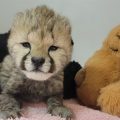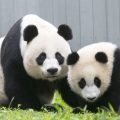Who you calling a cheetah?
Animal care staff have been able to weigh and inspect five cheetah cubs that were born May 28 at the Smithsonian Conservation Biology Institute in Front Royal, Va. The cubs appear to be healthy, doing well and are very active. On average, the cubs currently weigh about 2 pounds. Keepers will continue to monitor the newborns, while giving the mother, 6-year-old Amani, privacy to bond with her offspring.
“When I was weighing the last cub, he was being a very tough little guy,” said Adrienne Crosier, SCBI cheetah biologist. “We’re already starting to see differences in their dispositions and look forward to watching them grow and learning all we can from them.”
Cheetahs, the fastest animals on land, are struggling to outpace threats to their survival in the wild. Because of human conflict, hunting and habitat loss, there are only an estimated 7,500 to 10,000 cheetahs left in the wild. The International Union for Conservation of Nature considers cheetahs a vulnerable species.
Amani is a dedicated mother according to keepers, who have observed her nursing and grooming the cubs.
This litter is particularly significant to the Association of Zoos and Aquariums’ Species Survival Plan for cheetahs because cheetah births in zoos across the country have dwindled. The SSP matches animals across the country to ensure genetic diversity in the population. This is the only litter of cheetahs born this year in a North American zoo. Cheetah experts recently met to discuss dramatic management changes to bolster the population, recommending that cheetahs that are genetically valuable and of reproductive age be moved to one of nine breeding centers—eight in the United States and one in Canada. This will give the animals more space and mating options, increasing the odds of successful reproduction.
Click here for a short video of the 25-day-old cubs.
Posted: 8 July 2011
- Categories:










